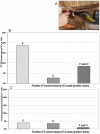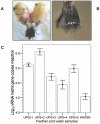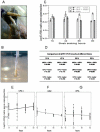Can preening contribute to influenza A virus infection in wild waterbirds?
- PMID: 20593026
- PMCID: PMC2892510
- DOI: 10.1371/journal.pone.0011315
Can preening contribute to influenza A virus infection in wild waterbirds?
Abstract
Wild aquatic birds in the Orders Anseriformes and Charadriiformes are the main reservoir hosts perpetuating the genetic pool of all influenza A viruses, including pandemic viruses. High viral loads in feces of infected birds permit a fecal-oral route of transmission. Numerous studies have reported the isolation of avian influenza viruses (AIVs) from surface water at aquatic bird habitats. These isolations indicate aquatic environments have an important role in the transmission of AIV among wild aquatic birds. However, the progressive dilution of infectious feces in water could decrease the likelihood of virus/host interactions. To evaluate whether alternate mechanisms facilitate AIV transmission in aquatic bird populations, we investigated whether the preen oil gland secretions by which all aquatic birds make their feathers waterproof could support a natural mechanism that concentrates AIVs from water onto birds' bodies, thus, representing a possible source of infection by preening activity. We consistently detected both viral RNA and infectious AIVs on swabs of preened feathers of 345 wild mallards by using reverse transcription-polymerase chain reaction (RT-PCR) and virus-isolation (VI) assays. Additionally, in two laboratory experiments using a quantitative real-time (qR) RT-PCR assay, we demonstrated that feather samples (n = 5) and cotton swabs (n = 24) experimentally impregnated with preen oil, when soaked in AIV-contaminated waters, attracted and concentrated AIVs on their surfaces. The data presented herein provide information that expands our understanding of AIV ecology in the wild bird reservoir system.
Conflict of interest statement
Figures



Similar articles
-
Survivability of highly pathogenic avian influenza virus (H5N1) in naturally preened duck feathers at different temperatures.Transbound Emerg Dis. 2019 May;66(3):1306-1313. doi: 10.1111/tbed.13148. Epub 2019 Mar 28. Transbound Emerg Dis. 2019. PMID: 30861310
-
Shedding light on avian influenza H4N6 infection in mallards: modes of transmission and implications for surveillance.PLoS One. 2010 Sep 20;5(9):e12851. doi: 10.1371/journal.pone.0012851. PLoS One. 2010. PMID: 20877466 Free PMC article.
-
A robust tool highlights the influence of bird migration on influenza A virus evolution.Mol Ecol. 2012 Dec;21(24):5905-7. doi: 10.1111/mec.12101. Mol Ecol. 2012. PMID: 23355978
-
[An overview of surveillance of avian influenza viruses in wild birds].Bing Du Xue Bao. 2014 May;30(3):310-7. Bing Du Xue Bao. 2014. PMID: 25118388 Review. Chinese.
-
A SYSTEMATIC REVIEW AND NARRATIVE SYNTHESIS OF THE USE OF ENVIRONMENTAL SAMPLES FOR THE SURVEILLANCE OF AVIAN INFLUENZA VIRUSES IN WILD WATERBIRDS.J Wildl Dis. 2021 Jan 6;57(1):1-18. doi: 10.7589/JWD-D-20-00082. J Wildl Dis. 2021. PMID: 33635994
Cited by
-
A highly pathogenic avian influenza virus H5N1 clade 2.3.4.4 detected in Samara Oblast, Russian Federation.Front Vet Sci. 2024 Feb 8;11:1244430. doi: 10.3389/fvets.2024.1244430. eCollection 2024. Front Vet Sci. 2024. PMID: 38389580 Free PMC article.
-
Anti-parasite behaviour of birds.Philos Trans R Soc Lond B Biol Sci. 2018 Jul 19;373(1751):20170196. doi: 10.1098/rstb.2017.0196. Philos Trans R Soc Lond B Biol Sci. 2018. PMID: 29866911 Free PMC article. Review.
-
Utility of Feathers for Avian Influenza Virus Detection in Commercial Poultry.Pathogens. 2023 Dec 7;12(12):1425. doi: 10.3390/pathogens12121425. Pathogens. 2023. PMID: 38133308 Free PMC article.
-
Genetic markers for rapid PCR-based identification of gull, Canada goose, duck, and chicken fecal contamination in water.Appl Environ Microbiol. 2012 Jan;78(2):503-10. doi: 10.1128/AEM.05734-11. Epub 2011 Nov 11. Appl Environ Microbiol. 2012. PMID: 22081573 Free PMC article.
-
Active Surveillance for Highly Pathogenic Avian Influenza Viruses in Wintering Waterbirds in Northeast Italy, 2020-2021.Microorganisms. 2021 Oct 20;9(11):2188. doi: 10.3390/microorganisms9112188. Microorganisms. 2021. PMID: 34835314 Free PMC article.
References
Publication types
MeSH terms
Substances
LinkOut - more resources
Full Text Sources
Medical

